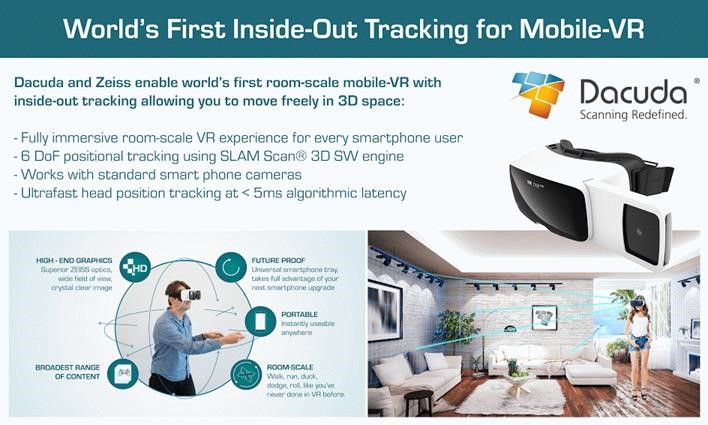Dacuda Claims 3D Tracking Parity With Tango, Will Demo On Zeiss VR One Plus HMD At CES
Zeiss is planning to use Dacuda's inside-out tracking technology to augment its VR One Plus HMD.
Showtime
Zeiss has so far offered no further details on how it plans to use Dacuda's technology; we know only that it’s happening, but certainly, that's some nifty technology to plug into the VR One Plus HMD.
Previously, the selling point of the VR One Plus has been the quality of the optics, which is, of course, Zeiss’ forte, but otherwise the $129 HMD seemed like little more than a glorified Google Cardboard headset. Now it’s getting inside-out, room scale tracking, which suddenly significantly increases its appeal.
Zeiss will be showing off the VR One Plus, equipped with its shiny new tracking tech, at CES 2017 next month.
The Tech
Dacuda offers an inexpensive software-based means of performing inside-out tracking. We saw the technology (SLAM Scan) working on an iPhone a few months ago, but now it’s added STMicroelectronics’ time-of-flight laser sensor to enable “metric 3D sensing” on standard smartphones. The company said that it would demo the new tech on a Google Pixel smartphone at CES in January.
In a press release, Dacuda stated:
Get Tom's Hardware's best news and in-depth reviews, straight to your inbox.
It enables use cases for measuring distances or estimating metric sizes of objects. The demonstration involves the scanning of food objects which might be used in the future as input for machine learning models to accurately predict calories. Further use cases envisage real-time 6DoF inside-out positional tracking for VR/AR at an unprecedented accuracy.
In the same release, STMicroelectronics’ Frederic Morestin said that the pairing of the two technologies “empowers end users with the exciting ability to perform 3D scanning, AR, and VR.”
The addition of time-of-flight, said Dacuda, brings it closer to parity with Google Tango’s metric 3D scanning.
Better Together
Before we learned that Zeiss was planning to leverage its tracking technology, Dacuda had let us know that it was going to be demonstrating it at Zeiss' CES booth, using the VR One Plus. The company stated, “The Zeiss VR One Plus has the best optics of any slot in headset currently on the market (with a great FOV), it's comfortable to wear, and you can wear it with glasses.”
Dacuda also noted that its software solution requires no setup and should work on “most modern smartphones that have enough processing power, an IMU, and a good camera.”
The additional scanning technology shouldn’t add much more to the cost of the VR One Plus, and we wouldn’t be shocked if Zeiss simply let the price tag stand as is. The VR One Plus supports iOS and Android devices with screen sizes between 4.7-5.5 inches.
If you’re at CES 2017, you’ll be able to see all of the above in action at Zeiss’ booth at the Las Vegas Convention Center.
Update, 12/17/16, 9:01am PT: An earlier version of this article stated that Zeiss was acquiring Dacuda, the company, but that was incorrect--the result of a misunderstanding. After we published, we were given more clarifying language that Zeiss is "acquiring"--meaning "adopting"--Dacuda's technology. We have corrected the article and changed the headline accordingly.
Seth Colaner previously served as News Director at Tom's Hardware. He covered technology news, focusing on keyboards, virtual reality, and wearables.
-
bit_user I hope they emulate the Tango API. If they did, they'd have ready access to some existing apps, plus developers wouldn't need to come up to speed on a new API & port their code to it.Reply -
wifiburger lol oh my, picked up a used kinect for my xbox 360 for 40$ and boy did the fun run out in a couple of minutes, imagine that with something strapped to your head !Reply
pass


